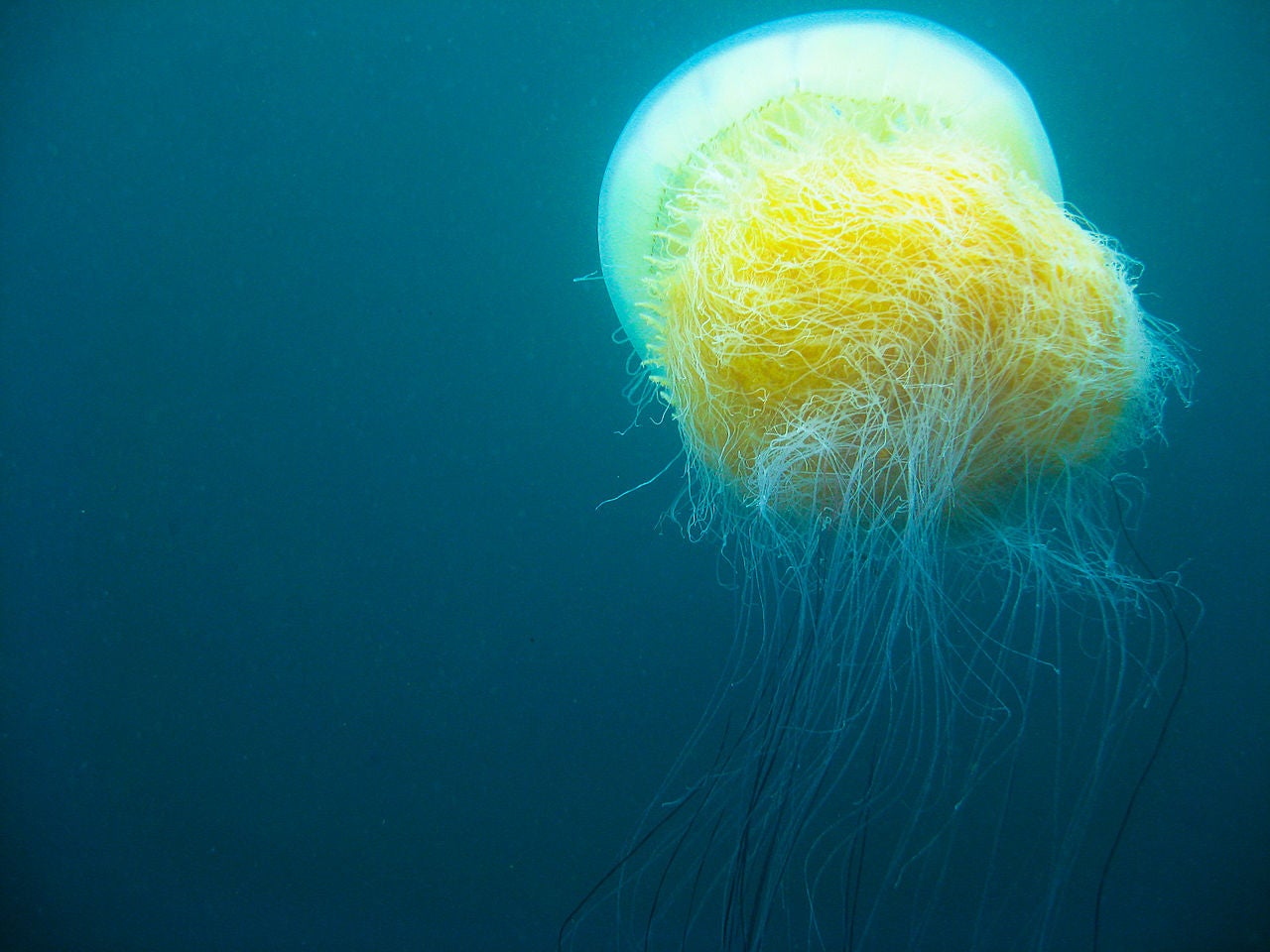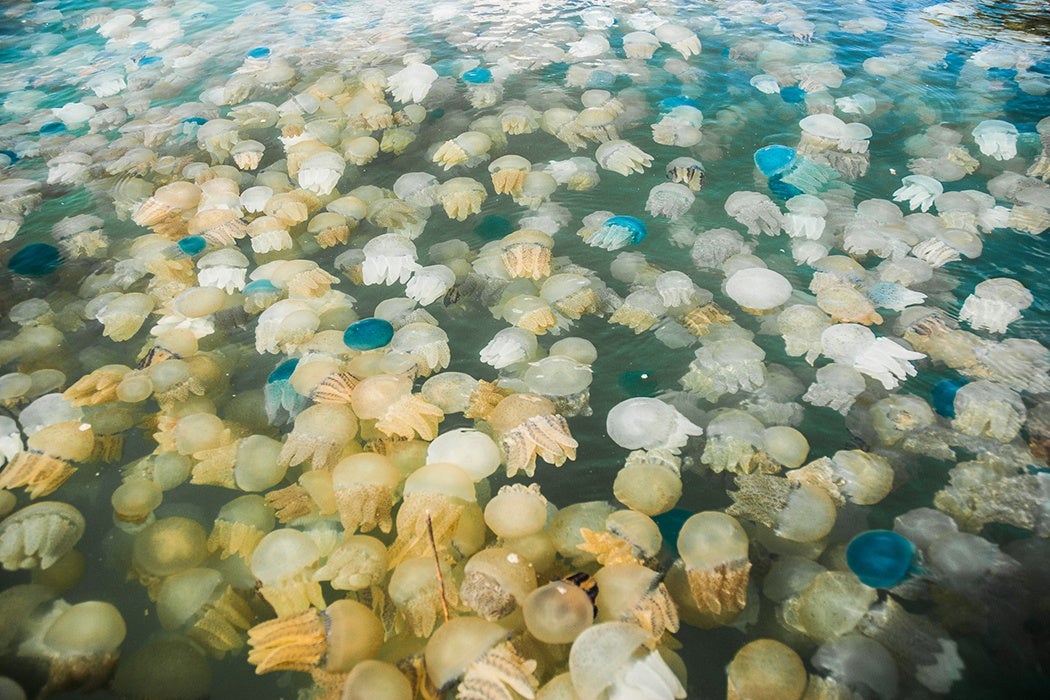Seen from high above, a jellyfish bloom is a single mass, a brushstroke on the ocean’s vast surface. Zoom in closer and the streaks begin to resolve themselves, separating into hundreds of individual pulsing forms that resemble animated contact lenses with the transparency of grocery bags. Closer still and details begin to emerge—a symmetric floral pattern in the center of each lens, a fringe of hairlike filaments ringing the edge. Plunge through the swarm of jellies and the bloom transforms again, into a forest of fringed tentacles borne by an undulating, milky canopy. From different angles, jellyfish blooms are at once beautiful, disastrous, neatly assembled, and out of control.
Although the term “jellyfish” implies a monolithic group of organisms, the name actually encompasses a broad swath of marine life. Thousands of species fall under the jellyfish umbrella, similar only in their basic body composition and tendency in undergoing sudden population booms. Some scientists use the term “gelatinous zooplankton” to more accurately capture the group’s diversity. There are parasitic jellies, jellies that hunt in the water column, and jellies that are anchored to the sea floor. The man o’ war—with its multicolored, balloon-like sail and ability to sting long after death—isn’t even a single organism, but a colony of co-dependent creatures with separate functions.
The elegant efficiency of the jellyfish’s structure may be one reason for the group’s diversity. Jellyfish bodies are at least 95% water; the remaining 5% or so contains the barest essentials needed to capture, consume, and use energy. Their method of locomotion, an elastic ring that contracts to rapidly expel water and propel the jelly forward, allows them to move more efficiently than any other organism. Their trailing tentacles brush against prey, immobilizing them and conveying them to the jellyfish’s mouth — after which the jelly digests its prey in its body cavity and subsequently expels the remaining parts of the prey through the same single opening.
The lack of complex physical features makes jellies extremely adaptable and the things that restrict other marine animals—such as temperature, acidity, salinity, light, or darkness—don’t faze them. They combine plantlike simplicity, animal-like mobility, and an almost bacterial ability to reproduce rapidly under favorable conditions. There’s even a species of jellyfish that achieves near-immortality by turning back into a polyp — a less mature version of itself — when injured. The polyp can then produce identical copies of the injured jelly and the jelly can revert back to the polyp again and again, indefinitely.
Given this formidable combination of traits, it’s surprising that jellyfish haven’t already taken over the world. Until now, they’ve been kept in check by marine predators, which eat jellies and their food sources. Seabirds, sea turtles, marine mammals, fish, and even other jellyfish have developed methods for overcoming the jellies’ defensive stings to take advantage of the abundant, accessible food source that they are. Just as populations of rodents boom when top predators are removed from their ecosystems, overfishing of predatory species such as tuna can result in population increases further down the food chain. With many of their predators in decline, jellies are freed from the predation and competition that otherwise keep them in check.
Meanwhile, jellyfish are uniquely poised to benefit from changing ocean conditions. Jellyfish can lie as polyps on the ocean floor for years, spawning only when conditions are favorable. Higher ocean temperatures mean that reproductive conditions that formerly occurred once every few decades now occur more frequently. And then there’s the issue of oxygen. In many parts of the ocean, high concentrations of agricultural nutrients cause plankton to grow explosively. This, in turn, depletes some areas of the ocean of oxygen, creating “dead zones.” Most marine life can’t survive in an oxygen-deprived environment — except for jellyfish. Bloodless and brainless, jellyfish are able to exist with very little oxygen. Far from inhospitable, dead zones become competition-free plankton buffets. Once jellies take over, their tendency to consume fish larvae makes it difficult for other species to re-colonize the area even after oxygen levels return to normal.

* * *
In recent years, Japan has been living this jellyfish-saturated vision of the future. Early in the twenty-first century, blooms of massive Nomura’s jellyfish suddenly began occurring annually, whereas they used to only happen once every forty years. (Authorities blamed the sudden uptick in jellyfish abundance on agricultural runoff from neighboring China, which may have provided favorable conditions for jellies to spawn.) Six feet wide and packing a brutal sting, the jellies clogged fishing nets, devastated fish populations both in farms and in the wild, and even caused a trawler to capsize.
Japanese scientists and entrepreneurs scrambled for solutions. Killing the jellies was out of the question because the jellies would then release eggs, which, in turn, could create new spawning areas. Jellies are edible but not appealing to eat. Medical uses have yet to be found. As a last resort, they could theoretically be reconstituted to fertilizer.
The past few years have brought a reprieve from Nomura’s blooms, but the years of high abundance provided a sobering window into what a jelly-dominated future might look like.
It’s easy and compelling to draw a direct link from human activity to increasing jellyfish populations. In their blind simplicity and poisonous beauty, jellies are hailed to be unstoppable in the face of ecological destruction. Recent reports of jellyfish blooms have closed beaches in the Mediterranean and clogged power plants in Sweden, feeding the prevailing impression of a dystopian, gelatinous future for marine environments. But how much science is there to back up this seemingly neat cause-and-effect relationship?
As it turns out, not nearly enough.
In 2012, a task force of international jellyfish experts evaluated the scientific evidence behind the theory that jellyfish blooms were increasing as a result of global temperature changes. What they found, first and foremost, was a lack of information. Jellyfish are notoriously difficult to study, blooming unexpectedly in inaccessible corners of the sea. The data that were available suggested a more complicated story, in which jellyfish blooms occur in waves that coincide with natural fluctuations in the environment. While there was a slight upward trend of blooms in recent years, that increase was within the normal range of variability.
The group didn’t reject the jellyfish-climate link, but they suggested that there might be other explanations for the increase in jellyfish abundance. For one, human activities occupy an ever-increasing portion of the ocean. Fish farms and power plants are multiplying along coastlines, and commercial fishing vessels are responding to decreased fish stocks by improving fishing equipment, traveling to new areas for fishing, and harvesting new species. These activities could bring humans into more frequent contact with jellies, increasing the visibility and economic cost of jellyfish blooms even without any increase in the frequency of the blooms themselves. On the other hand, the jellyfish-climate narrative tends to stoke media attention, feeding the perception that blooms are increasing when, in reality, they’re just getting more coverage.
In the meantime, the jellyfish-climate story takes a simplistic view of a diverse group of organisms. Only a few of the ten thousand species of jellyfish have been involved in the blooms that have been documented. The number of many other jellyfish species are stable, decreasing, or simply too elusive to count. Lumping all jellies under the nuisance banner ignores those species that are less able to thrive in the face of human disturbance. Ultimately, long-term data collection is the only way to separate perception from reality. The jellyfish experts’ work emphasizes the need for concrete data, rather than neat anecdotes, to back up predictions for the future of gelatinous zooplankton.
At the same time, if jellyfish populations really are increasing, Japan’s response to giant jellyfish blooms might provide an example of how to increase the economic benefits of jellyfish relative to their costs. The jellyfish task force suggests finding ways to transform over-abundant jellies into an ecosystem service. Even if jellies never become a culinary delicacy, a jellyfish economy may be the only way to adapt to balance out the negative impact of booming populations.
* * *
On a recent trip to the Seattle Aquarium, I stood inside a tunnel-shaped tank of moon jellies. As the jellies revolved around me, arching over my head then descending to my feet, I watched their appearance shift. They transformed with each change in angle and light: now round, now mushroom-shaped, now translucent, now glowing. Jellies can squeeze their boneless bodies through impossibly tiny openings or join their expanded bells to cover vast stretches of ocean. At different stages of their lives, they can be stationary anemones or free-floating sacs.
Man-made plague or natural oscillation, economic burden or business opportunity—jellies have a remarkable ability to shift depending on how you look at them. As we head into an uncertain environmental future, jellyfish provide a much-needed reminder of both the perils of shifting ecosystems and the importance of perspective.







